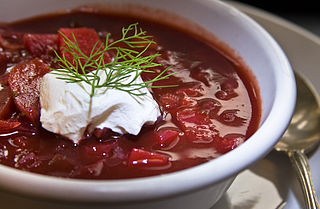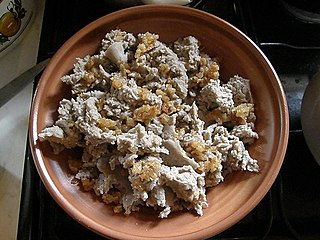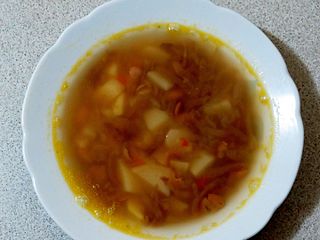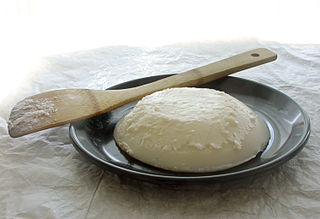Related Research Articles

Borscht is a sour soup, made with meat stock, vegetables and seasonings, common in Eastern Europe and Northern Asia. In English, the word borscht is most often associated with the soup's variant of Ukrainian origin, made with red beetroots as one of the main ingredients, which give the dish its distinctive red color. The same name, however, is also used for a wide selection of sour-tasting soups without beetroots, such as sorrel-based green borscht, rye-based white borscht, and cabbage borscht.

Roux is a mixture of flour and fat cooked together and used to thicken sauces. Roux is typically made from equal parts of flour and fat by weight. The flour is added to the melted fat or oil on the stove top, blended until smooth, and cooked to the desired level of brownness. A roux can be white, blond (darker) or brown. Butter, bacon drippings or lard are commonly used fats. Roux is used as a thickening agent for gravy, sauces, soups and stews. It provides the base for a dish, and other ingredients are added after the roux is complete.

Refried beans is a dish of cooked and mashed beans that is a traditional staple of Mexican and Tex-Mex cuisine, although each cuisine has a different approach when making the dish. Refried beans are also popular in many other Latin American countries. The English "refried beans" is a mistranslation, since the essence of "frijoles refritos" is the reheating and mashing of the beans.

Russian cuisine is a collection of the different dishes and cooking traditions of the Russian people as well as a list of culinary products popular in Russia, with most names being known since pre-Soviet times, coming from all kinds of social circles.

Prekmurska gibanica is a type of Slovenian gibanica or layered pastry. It contains poppy seeds, walnuts, apples, raisins and quark fillings. Although native to Prekmurje, it has achieved the status of a national specialty of Slovenia. The unique sweetmeat shows the variety of agriculture in this region. The name gibanica comes from the dialect expression güba and in this case refers to a fold.

Tripe soup or tripe stew is a soup or stew made with tripe. It is widely considered to be a hangover remedy.

A lardon, also spelled lardoon, is a small strip or cube of fatty bacon, or pork fat, used in a wide variety of cuisines to flavor savory food and salads. In French cuisine, lardons are also used for larding, by threading them with a needle into meats that are to be braised or roasted. Lardons are not normally smoked, and they are made from pork that has been cured with salt.

Pörkölt is a meat stew which originates from Hungary, but is eaten throughout Central Europe.

Peranakan cuisine or Nyonya cuisine comes from the Peranakans, descendants of early Chinese migrants who settled in Penang, Malacca, Singapore and Indonesia, inter-marrying with local Malays. In Baba Malay, a female Peranakan is known as a nonya, and a male Peranakan is known as a baba. The cuisine combines Chinese, Malay, Javanese, South Indian, and other influences.

Žganci is a dish in Slovenian and Croatian cuisine, also called pura on the Croatian coast. It is a traditional "poor man's food" of hard-working farmhands similar to polenta, although prepared with finer grains.

Slovenian cuisine is influenced by the diversity of Slovenia's landscape, climate, history and neighbouring cultures. In 2016, the leading Slovenian ethnologists divided the country into 24 gastronomic regions. The first Slovene-language cookbook was published by Valentin Vodnik in 1798.

Matevž is a Slovene national dish. The dish is typical of central Slovenia, especially of the Kočevje region. It is made of beans and potatoes. Its origins come from the 19th century. Originally, the lower social classes ate it as a main course. The dish is also known as krompirjev mož 'potato mush', belokranjski mož 'White Carniola mush', or medved. The term matevž is a derivative from male name Matej or Matevž (Matthew). Matej or Matevž word origins to many other dialectical expressions: to have matevža means to have a hangover.

The jota or Istrian stew is a soup made with beans and sauerkraut or sour turnip, potatoes, bacon, and spare ribs, known in the northern Adriatic regions. Under the name jota, it is typical and especially popular in Trieste and its province, in the Istrian peninsula, in the province of Gorizia, in the whole Slovenian Littoral, in the Rijeka area, and in Friuli, especially in some of its peripheral areas. The stew, based on etymology, most likely originated in Friuli before spreading east and south.

Obara (stew) is a Slovene national dish. It is a stew served as an independent meal, which is cooked from various kinds of meat and internal organs. It used to be served at various ceremonies, and it is a part of the traditional Slovenian cuisine. Especially good are obaras served with ajdovi žganci. Today obaras contain more vegetables.
Belokranjska povitica is a Slovenian national dish. It was supposedly brought to the White Carniola region by the Uskoks, who were Croatian Habsburg soldiers that inhabited the areas of the eastern Adriatic area. The name itself, povitica, explains the preparation. The term povitica derived from the verb poviti 'to roll'.
Styrian sour soup is a sour soup that originates from Lower Styria.

Lard is a semi-solid white fat product obtained by rendering the fatty tissue of a pig. It is distinguished from tallow, a similar product derived from fat of cattle or sheep.

Bavarian cuisine is a style of cooking from Bavaria, Germany. Bavarian cuisine includes many meat and Knödel dishes, and often uses flour. Due to its rural conditions and Alpine climate, primarily crops such as wheat, barley, potatoes, beets, carrots, onion and cabbage do well in Bavaria, being a staple in the German diet.

Caldo galego or simply caldo, also known as caldo gallego, meaning literally "Galician broth", is a traditional soup dish from Galicia. It is essentially a regional derivative of the very similar caldo verde, the traditional soup dish of neighbouring Portugal.
References
- ↑ Slovenian Cuisine: Cookbook of Southern Slavs. L.Prochazka (2017) 90 pag. ISBN 1979472424, ISBN 978-1979472425
- ↑ The Food and Cooking of Slovenia: Traditions, ingredients, tastes & techniques in over 60 classic recipes . J,Bogataj (2009) 128 pag. ISBN 1903141605, ISBN 9781903141601
- ↑ Taste Slovenia. Bogataj Janez, 2007. Rokus Gifts. ISBN 978-961-6531-39-9